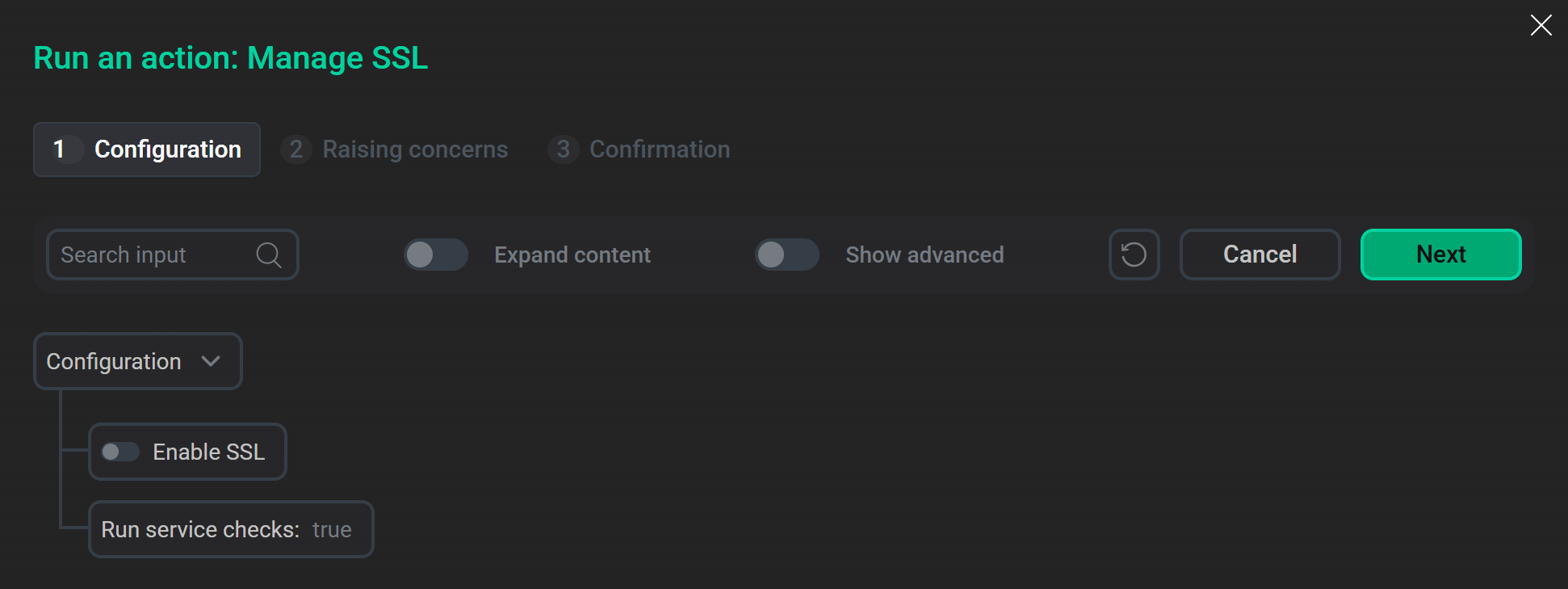

SSL encryption
For secure connections to ADQM clusters and protection of data exchange between service components, ADQM Control supports SSL encryption. To use this feature in your ADQM Control cluster, obtain certificates and enable SSL in ADCM UI.
The example in this article uses an ADQM Control cluster that includes two hosts, on which components of ADQM Control’s services are distributed as follows:
-
10.92.41.249, dev-adqm-c-01.arenadata.local — all components of the ADQM Control service and the Zookeeper Server component of the Zookeeper service;
-
10.92.41.23, dev-adqm-c-02.arenadata.local — the Arenadata PostgreSQL component of the ADPG service.
ADQM Control is integrated with an ADQM cluster for which SSL encryption of connections is enabled according to the tutorial from the Encryption of database connections article of the ADQM documentation.
For demonstration and testing purposes, server SSL certificates are signed with a self-signed CA certificate (its creation is also described in the article with an example of setting up SSL for ADQM — see the steps 1 and 2 in the Create SSL certificates section). In production systems, use a trusted certificate authority to sign certificates.
Create SSL certificates
To create and register SSL certificates with the commands listed below, use the openssl utility (minimum version 1.1.1).
-
For each host of the ADQM Control cluster, generate a key and create a certificate signing request (CSR):
$ openssl req -newkey rsa:2048 -nodes \ -subj "/CN=dev-adqm-c-01.arenadata.local" \ -addext "subjectAltName = DNS:dev-adqm-c-01.arenadata.local,IP:10.92.41.249" \ -keyout adqm-c-host-01.key -out adqm-c-host-01.csr$ openssl req -newkey rsa:2048 -nodes \ -subj "/CN=dev-adqm-c-02.arenadata.local" \ -addext "subjectAltName = DNS:dev-adqm-c-02.arenadata.local,IP:10.92.41.23" \ -keyout adqm-c-host-02.key -out adqm-c-host-02.csrThe CN (Common Name) certificate identifier should be the fully qualified domain name (FQDN) of a host for which the certificate is being created. Otherwise, the certificate cannot be verified.
-
For each host, create and sign a certificate using the CA certificate and private key:
$ openssl x509 -req \ -in adqm-c-host-01.csr \ -out adqm-c-host-01.crt \ -CAcreateserial -CA arenadata_ca.crt -CAkey arenadata_ca.key \ -days 365$ openssl x509 -req \ -in adqm-c-host-02.csr \ -out adqm-c-host-02.crt \ -CAcreateserial -CA arenadata_ca.crt -CAkey arenadata_ca.key \ -days 365As mentioned above, the server certificates in this example are signed by the same certificate authority as the certificates in the example of configuring SSL for an ADQM cluster — see the Encryption of database connections article in the ADQM documentation for a description of how to create the CA certificate (arenadata_ca.crt) and private key (arenadata_ca.key) files.
-
Copy files of server certificates and keys, as well as the CA certificate to the cluster hosts where components of ADQM Control’s services are installed. For the Backend, Agents, Alert Generator, and Alert Receiver components of the ADQM Control service, these files should be stored in the same path and named the same on each host where these components are installed. For the Alertmanager component and components of other services (ADPG, Zookeeper, Monitoring), separate directories are used to store these files. Paths and file names of server certificates/keys and CA certificates are specified in the SSL-related settings of the corresponding services of ADQM Control (see the SSL parameters in service configurations section below).
In the current example, SSL will be enabled for all components of the ADQM Control service and for the ADPG service. Therefore, it is necessary to place the created certificate/key files on hosts of the ADQM Control cluster as follows:-
For the Backend, Agents, Alert Generator, and Alert Receiver components of the ADQM Control service, copy files to the dev-adqm-c-01.arenadata.local host:
-
adqm-c-host-01.crt to /etc/adqmc/server.crt;
-
adqm-c-host-01.key to /etc/adqmc/server.key;
-
arenadata_ca.crt to /etc/adqmc/ca.crt.
-
-
For the Alertmanager component of the ADQM Control service, copy files to the dev-adqm-c-01.arenadata.local host:
-
adqm-c-host-01.crt to /etc/admprom/alert-manager/server.crt;
-
adqm-c-host-01.key to /etc/admprom/alert-manager/server.key;
-
arenadata_ca.crt to /etc/admprom/alert-manager/ca.crt.
-
-
For the ADPG service, copy files to the dev-adqm-c-02.arenadata.local host:
-
adqm-c-host-02.crt to /etc/adpg16/server.crt;
-
adqm-c-host-02.key to /etc/adpg16/server.key;
-
arenadata_ca.crt to /etc/adpg16/ca.crt.
-
-
Configure ADQM Control to enable SSL encryption
You can enable SSL encryption of connections in ADQM Control using the ADCM interface, which provides the following functionality for this:
-
Manage SSL cluster action — allows you to enable SSL for multiple components of ADQM Control’s services at once.
-
SSL settings in configurations of ADQM Control’s services — allow you to configure SSL for each service separately (for example, you can change the default paths to certificate and key files).
Manage SSL cluster action
-
On the Clusters page, click the icon
in the ADQM Control cluster row to open the list of cluster actions and select Manage SSL.
 Launch the "Manage SSL" action
Launch the "Manage SSL" actionADCM will display a dialog window. When you turn on the Enable SSL switch, it provides options allowing you to specify which services of ADQM Control should use secure connections.
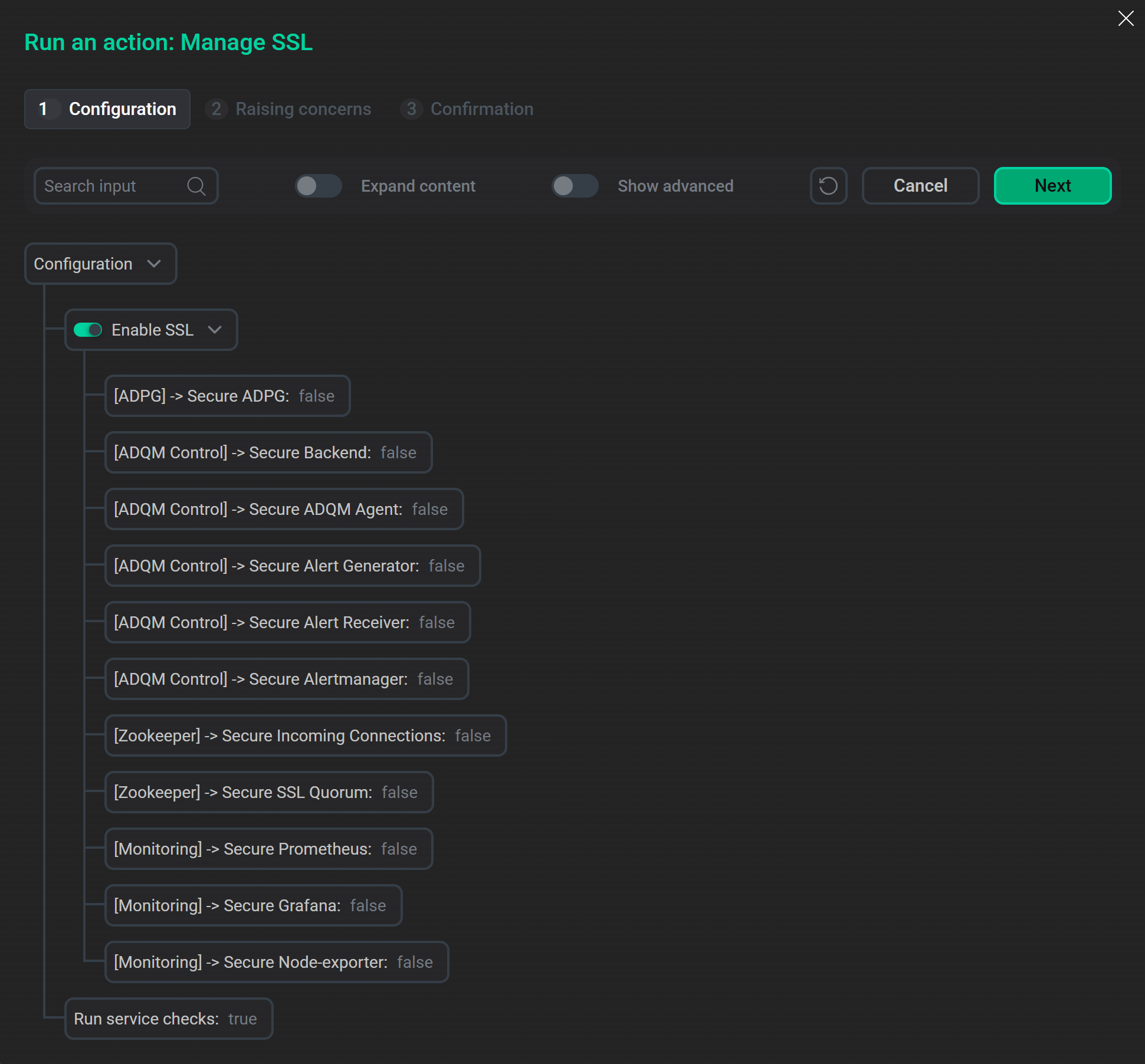 Options for enabling SSL in the "Manage SSL" action configuration window
Options for enabling SSL in the "Manage SSL" action configuration window -
Fill in the required parameters in the Manage SSL action configuration window:
-
Parameters in the Enable SSL section — to enable SSL encryption of incoming and internal connections for various services of ADQM Control.
Parameters to enable SSL for servicesParameter values specified in the Manage SSL action window overwrite the values of the corresponding parameters in service configurations after the action execution — see the Service parameter column in the table below.
Manage SSL parameter Parameter description Service parameter [ADPG] → Secure ADPG
Enables SSL encryption of connections to the data storage
ADPG service: Enable SSL parameter
[ADQM Control] → Secure Backend
Enables SSL encryption of connections to the Backend component of the ADQM Control service
ADQM Control service: [ADQM Control’s Backend] → Enable SSL parameter
[ADQM Control] → Secure ADQM Agent
Enables SSL encryption of connections to the Agents component of the ADQM Control service
ADQM Control service: [ADQM Control’s ADQM Agent] → Enable SSL parameter
[ADQM Control] → Secure Alert Generator
Enables SSL encryption of connections to the Alert Generator component of the ADQM Control service
ADQM Control service: [ADQM Control’s Alert Generator] → Enable SSL parameter
[ADQM Control] → Secure Alert Receiver
Enables SSL encryption of connections to the Alert Receiver component of the ADQM Control service
ADQM Control service: [ADQM Control’s Alert Receiver] → Enable SSL parameter
[ADQM Control] → Secure Alertmanager
Enables SSL encryption of connections to the Alertmanager component of the ADQM Control service
ADQM Control service: [Alertmanager] → Enable SSL parameter
[Zookeeper] → Secure Incoming Connections
Enables SSL encryption of connections to ZooKeeper
Zookeeper service: Enable SSL parameter
[Zookeeper] → Secure SSL Quorum
Enables SSL-encrypted quorum communication in ZooKeeper
Zookeeper service: sslQuorum parameter
[Monitoring] → Secure Prometheus
Enables SSL encryption of connections to the Prometheus Server component of the Monitoring service
Monitoring service: [Prometheus] → Enable SSL parameter
[Monitoring] → Secure Grafana
Enables SSL encryption of connections to the Grafana component of the Monitoring service
Monitoring service: [Grafana] → Enable SSL parameter
[Monitoring] → Secure Node-exporter
Enables SSL encryption of connections to the Node Exporter component of the Monitoring service
Monitoring service: [Node-exporter] → Enable SSL parameter
-
The Run service checks parameter — to specify whether to check the cluster health and availability after applying the settings.
-
-
To launch the action, click Next and then Run in the confirmation window.
During the Manage SSL action execution, ADCM stops all services one by one, reconfigures them to enable or disable SSL encryption, then starts the services again and checks them.
You can view the result of the action and its execution process on the Jobs page, which displays the execution details for all internal steps of actions, including verbose Ansible stdout/stderr outputs.
SSL parameters in service configurations
An alternative way to set up secure connections in ADQM Control is to configure SSL settings for each service separately.
-
Open the Services tab of your ADQM Control cluster and select the service for which you want to enable SSL encryption — ADPG, ADQM Control, Zookeeper, or Monitoring.
-
On the Primary configuration tab, configure the SSL parameters — the name of the section where these parameters are located depends on the service.
ADPG: SSL Configuration
In the SSL Configuration section of the ADPG service configuration, the following parameters are available.Parameter Description Default value Enable SSL
Enables secure incoming connections in the data storage
Disabled
Certificate file
Path to the server SSL certificate file in the CRT format (*.crt file). The certificate file should be located at the specified path on the cluster host where the Arenadata PostgreSQL component of the ADPG service is installed
/etc/adpg16/server.crt
Private key file
Path to the file with the private key of the server SSL certificate (*.key file). The key file should be located at the specified path on the cluster host where the Arenadata PostgreSQL component of the ADPG service is installed
/etc/adpg16/server.key
Certificate authority file
Path to the CA certificate file in the CRT format (*.crt file). The CA certificate file should be located at the specified path on the cluster host where the Arenadata PostgreSQL component of the ADPG service is installed
/etc/adpg16/ca.crt
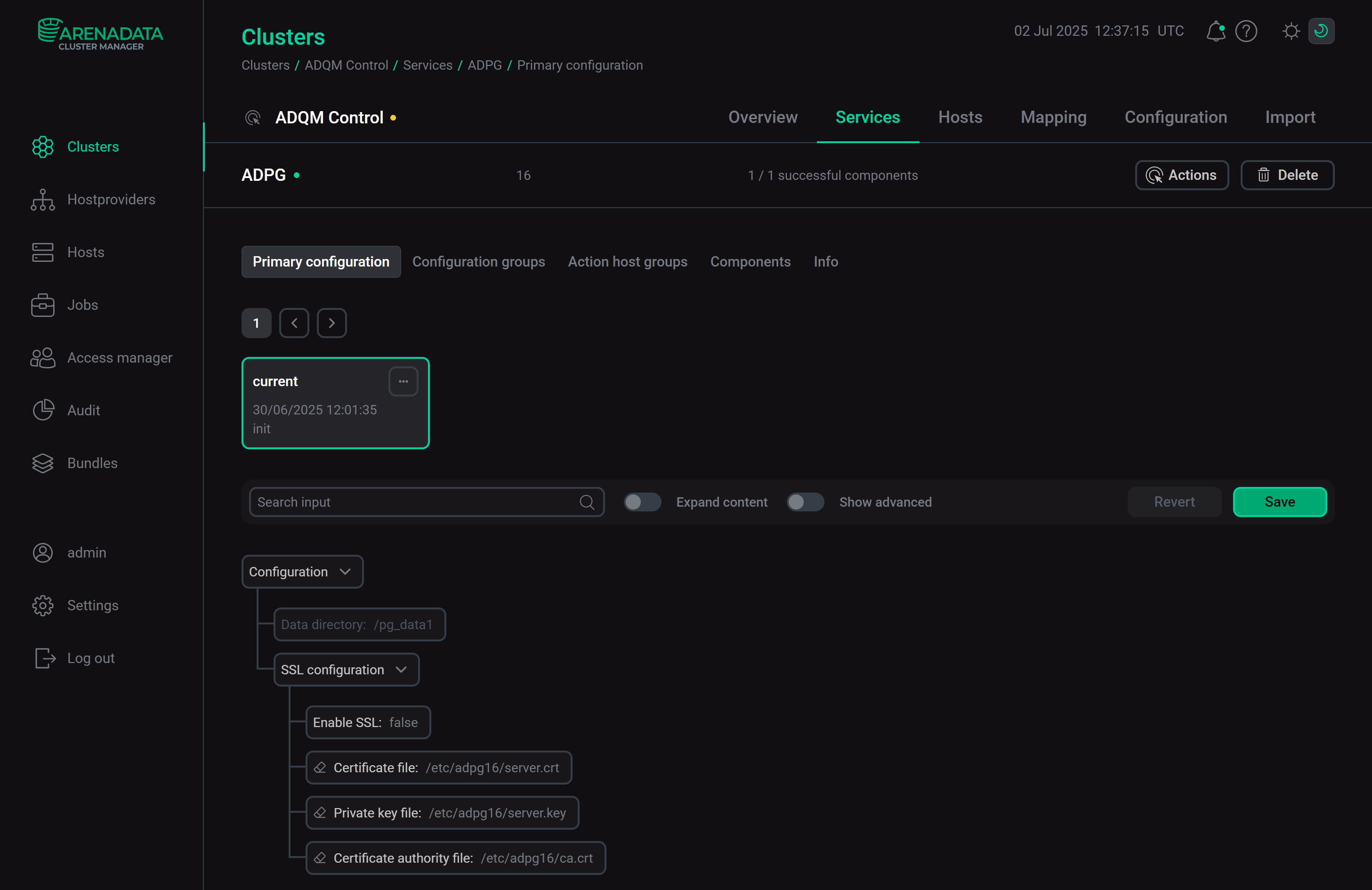 ADPG service configuration parameters to check SSL certificates of connectionsADQM Control: SSL configuration
ADPG service configuration parameters to check SSL certificates of connectionsADQM Control: SSL configuration
In the SSL Configuration section of the ADQM Control service configuration, the following parameters are available.Parameter Description Default value [ADQM Control’s Backend] → Enable SSL
Enables SSL encryption of incoming connections for the Backend component
Disabled
[ADQM Control’s ADQM Agent] → Enable SSL
Enables SSL encryption of incoming connections for the Agents component
Disabled
[ADQM Control’s Alert Generator] → Enable SSL
Enables SSL encryption of incoming connections for the Alert Generator component
Disabled
[ADQM Control’s Alert Receiver] → Enable SSL
Enables SSL encryption of incoming connections for the Alert Receiver component
Disabled
[Alertmanager] → Enable SSL
Enables SSL encryption of incoming connections for the Alertmanager component
Disabled
[ADQM Control Services] → Certificate file
Path to the server SSL certificate file in the CRT format (*.crt file) for the Backend, Agents, Alert Generator, and Alert Receiver components. The certificate file should be located at the specified path on each host of the cluster where these components are installed
/etc/adqmc/server.crt
[ADQM Control Services] → Private key file
Path to the file with the private key of the server SSL certificate (*.key file) for the Backend, Agents, Alert Generator, and Alert Receiver components. The key file should be located at the specified path on each host of the cluster where these components are installed
/etc/adqmc/server.key
[ADQM Control Services] → Certificate authority file
Path to the CA certificate file in the CRT format (*.crt file) for the Backend, Agents, Alert Generator, and Alert Receiver components. The CA certificate file should be located at the specified path on each host of the cluster where these components are installed
/etc/adqmc/ca.crt
[Alertmanager] → Certificate file
Path to the server SSL certificate file in the CRT format (*.crt file) for the Alertmanager component. The certificate file should be located at the specified path on the cluster host where the Alertmanager component is installed
/etc/admprom/alert-manager/server.crt
[Alertmanager] → Private key file
Path to the file with the private key of the server SSL certificate (*.key file) for the Alertmanager component. The key file should be located at the specified path on the cluster host where the Alertmanager component is installed
/etc/admprom/alert-manager/server.key
[Alertmanager] → Certificate authority file
Path to the CA certificate file in the CRT format (*.crt file) for the Alertmanager component. The CA certificate file should be located at the specified path on the cluster host where the Alertmanager component is installed
/etc/admprom/alert-manager/ca.crt
 Configuration parameters of the ADQM Control service to check SSL certificates of connectionsADQM Control: ADQM management
Configuration parameters of the ADQM Control service to check SSL certificates of connectionsADQM Control: ADQM management
The Connection type parameter in the ADQM management section of the ADQM Control service configuration allows you to enable the use of only secure TCP connections between ADQM Control and ADQM. If the ADQMDB service’s Network → Enable tcp parameter in ADQM is set tofalse, the Connection type parameter of ADQM Control should be set toSecure (TCP secure).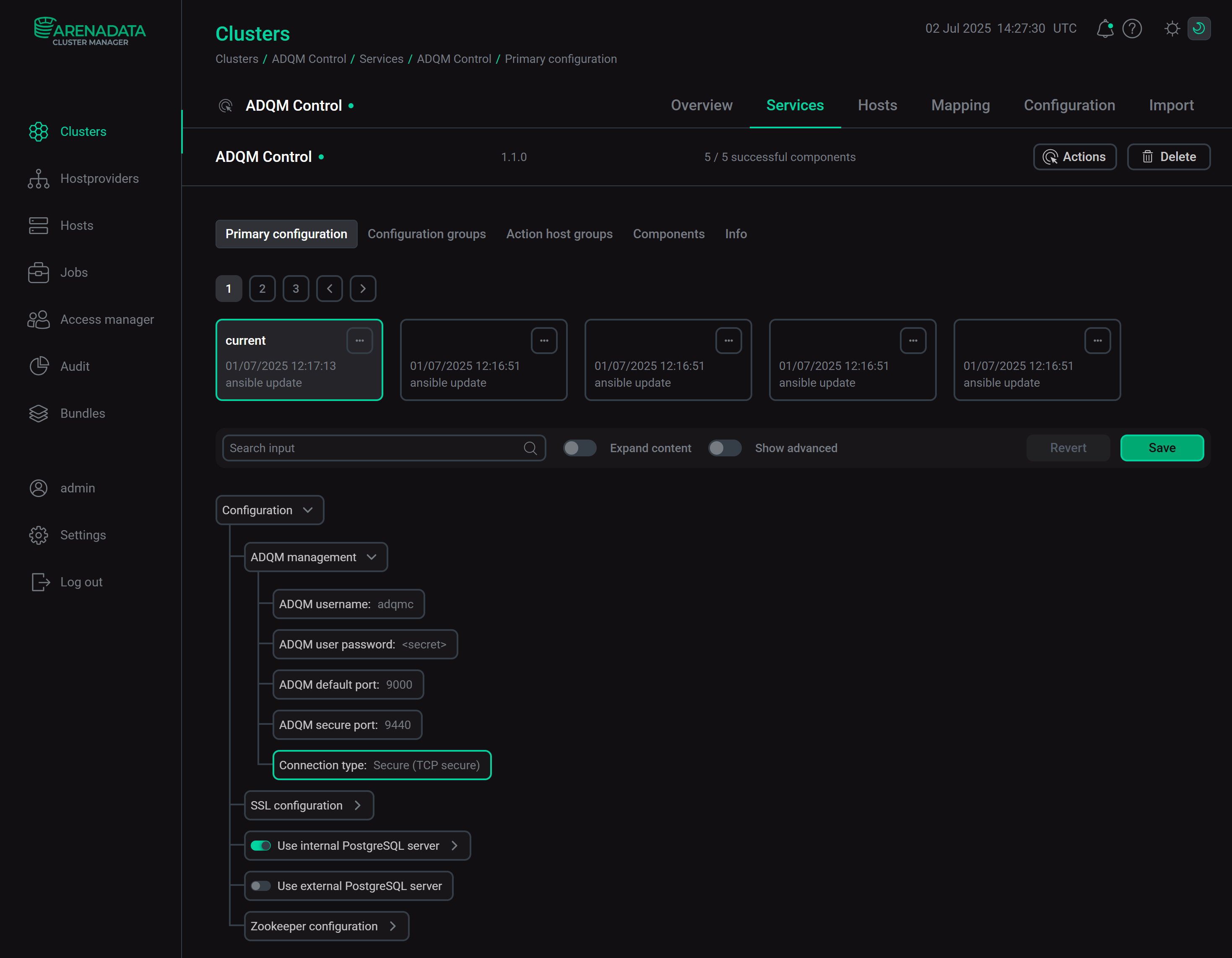 Enable the use of only secure TCP connections to ADQMADQM Control: Zookeeper configuration
Enable the use of only secure TCP connections to ADQMADQM Control: Zookeeper configurationIn the Zookeeper configuration section of the ADQM Control service configuration, the SSL connection parameter allows you to enable SSL encryption of connections to ZooKeeper.
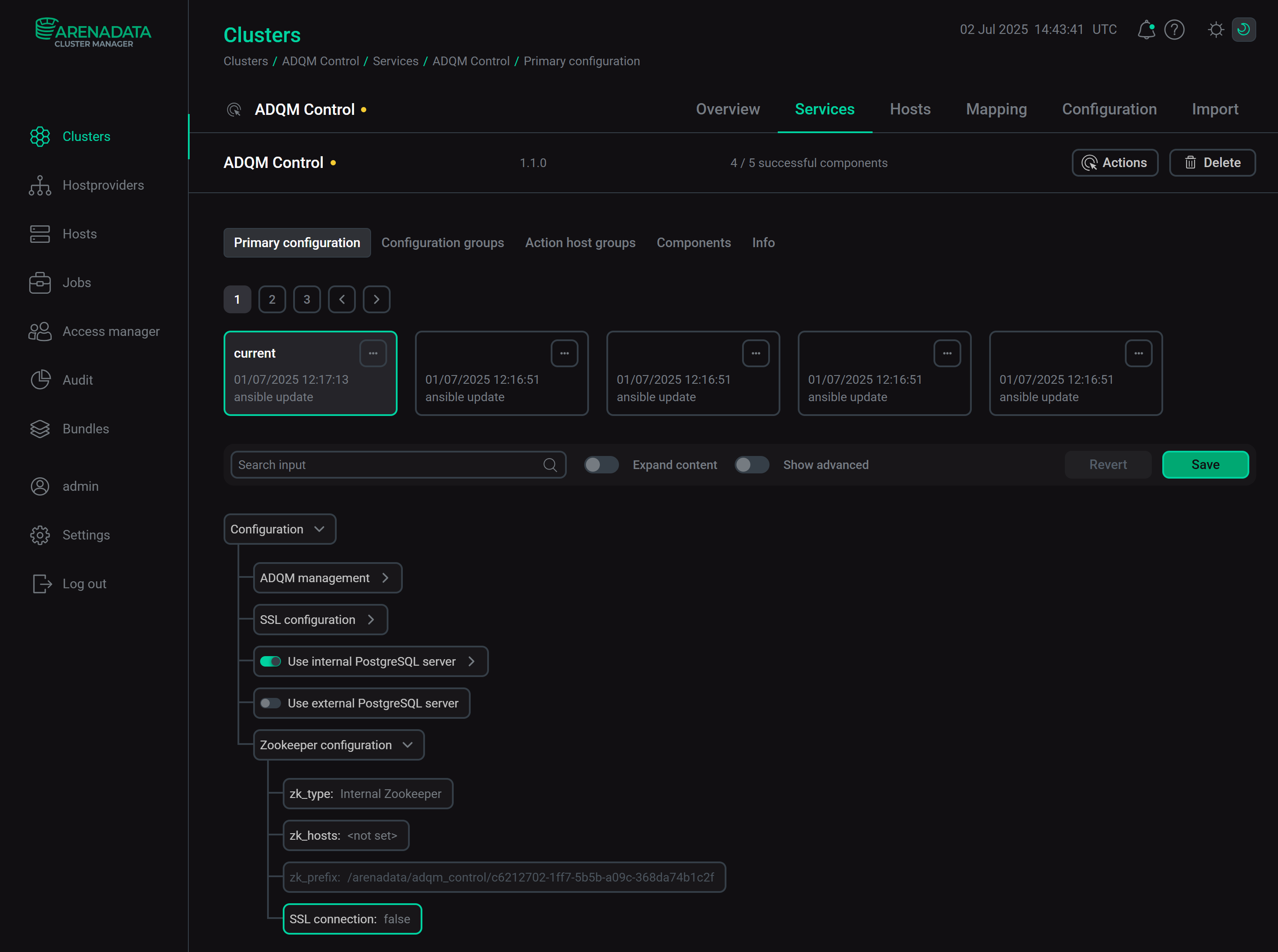 Turn on secure connections to ZookeeperZookeeper: SSL configuration
Turn on secure connections to ZookeeperZookeeper: SSL configurationThe SSL configuration section on the Zookeeper service configuration page contains the following parameters to set up SSL encryption of incoming and internal connections in ZooKeeper (keystore and truststore files should be stored at the specified paths on all cluster hosts where Zookeeper Server is installed).
Parameter Description Default value Enable SSL
Enables secure incoming connections in ZooKeeper
Disabled
sslQuorum
Enables encrypted quorum communication
Disabled
serverCnxnFactory
Specifies
ServerCnxnFactoryimplementation (to use TLS-based server communication, set it toNettyServerCnxnFactory)org.apache.zookeeper.server.NettyServerCnxnFactory
ssl.quorum.keyStore.location
Path to the server keystore file
/etc/zookeeper/server.jks
ssl.quorum.keyStore.password
Password for the keystore specified in
ssl.quorum.keyStore.location—
ssl.quorum.trustStore.location
Path to the server truststore file
/etc/zookeeper/ca.jks
ssl.quorum.trustStore.password
Password for the truststore specified in
ssl.quorum.trustStore.location—
ssl.keyStore.location
Path to the server keystore file to be used for client TLS connections
/etc/zookeeper/server.jks
ssl.keyStore.password
Password for the keystore specified in
ssl.keyStore.location—
ssl.trustStore.location
Path to the server truststore file to be used for client TLS connections
/etc/zookeeper/ca.jks
ssl.trustStore.password
Password for the truststore specified in
ssl.trustStore.location—
ssl.protocol
Protocol to be used in client TLS negotiation
TLSv1.2
ssl.quorum.protocol
Protocol to be used in quorum TLS negotiation
TLSv1.2
secureClientPort
Port to be used for secure client connections
2281
 Zookeeper service configuration parameters for SSL connectionsMonitoring: SSL configuration
Zookeeper service configuration parameters for SSL connectionsMonitoring: SSL configurationThe following parameters in the SSL configuration section of the Monitoring service configuration allows you to enable SSL-encrypted connections to service components (certificate/key files should be stored at the specified paths on all cluster hosts where the corresponding components of monitoring are installed).
Parameter Description Default value [Prometheus] → Enable SSL
Enables SSL encryption of incoming connections for Prometheus Server
Disabled
[Prometheus] → Certificate file
Path to the server SSL certificate file in the CRT format (*.crt file) for Prometheus Server
/etc/admprom/prometheus/server.crt
[Prometheus] → Private key file
Path to the file with the private key of the server SSL certificate (*.key file) for Prometheus Server
/etc/admprom/prometheus/server.key
[Prometheus] → Certificate authority file
Path to the file with the CA certificate in the CRT format (*.crt file) to verify Prometheus targets
/etc/admprom/prometheus/ca.crt
[Grafana] → Enable SSL
Enables SSL encryption of incoming connections for Grafana
Disabled
[Grafana] → Certificate file
Path to the server SSL certificate file in the CRT format (*.crt file) for Grafana
/etc/admprom/grafana/server.crt
[Grafana] → Private key file
Path to the file with the private key of the server SSL certificate (*.key file) for Grafana
/etc/admprom/grafana/server.key
[Grafana] → Certificate authority file
Path to the file with the CA certificate in the CRT format (*.crt file) to verify Prometheus certificate
/etc/admprom/grafana/ca.crt
[Node-exporter] → Enable SSL
Enables SSL encryption of incoming connections for node exporters
Disabled
[Node-exporter] → Certificate file
Path to the server SSL certificate file in the CRT format (*.crt file) for node exporters
/etc/ssl/server.crt
[Node-exporter] → Private key file
Path to the file with the private key of the server SSL certificate (*.key file) for node exporters
/etc/ssl/server.key
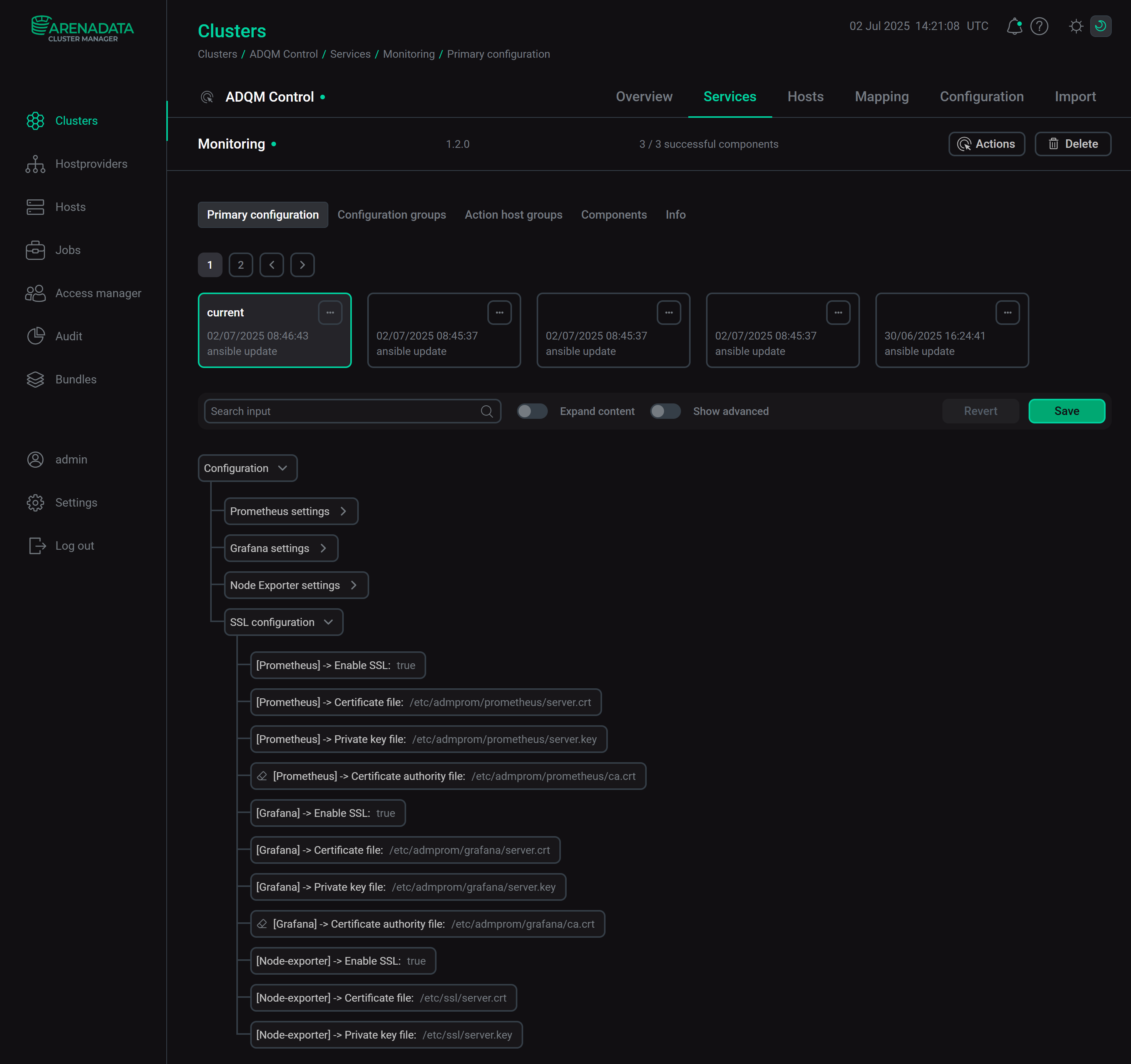 Configuration parameters of the Monitoring service for SSL connections
Configuration parameters of the Monitoring service for SSL connections -
After specifying all the necessary parameters for configuring SSL connections, click Save and run Reconfigure and restart for a service to apply the changes.
Example
-
In the ADQM management section of the ADQM Control service configuration, set the Connection type parameter to
Secure (TCP secure)so that ADQM Control can connect to ADQM only through the TCP port for SSL-secured communication (ADQM secure port). Option to enable the use of only secure TCP connections to ADQM
Option to enable the use of only secure TCP connections to ADQMClick Save.
-
Run the Manage SSL action for the cluster. In the configuration window that appears, activate Enable SSL and also turn on the following options to encrypt traffic between ADQM Control service components:
-
[ADPG] → Secure ADPG
-
[ADQM Control] → Secure Backend
-
[ADQM Control] → Secure ADQM Agent
-
[ADQM Control] → Secure Alert Generator
-
[ADQM Control] → Secure Alert Receiver
-
[ADQM Control] → Secure Alertmanager
 Enable SSL in ADQM Control via the "Manage SSL" cluster action
Enable SSL in ADQM Control via the "Manage SSL" cluster action
-
